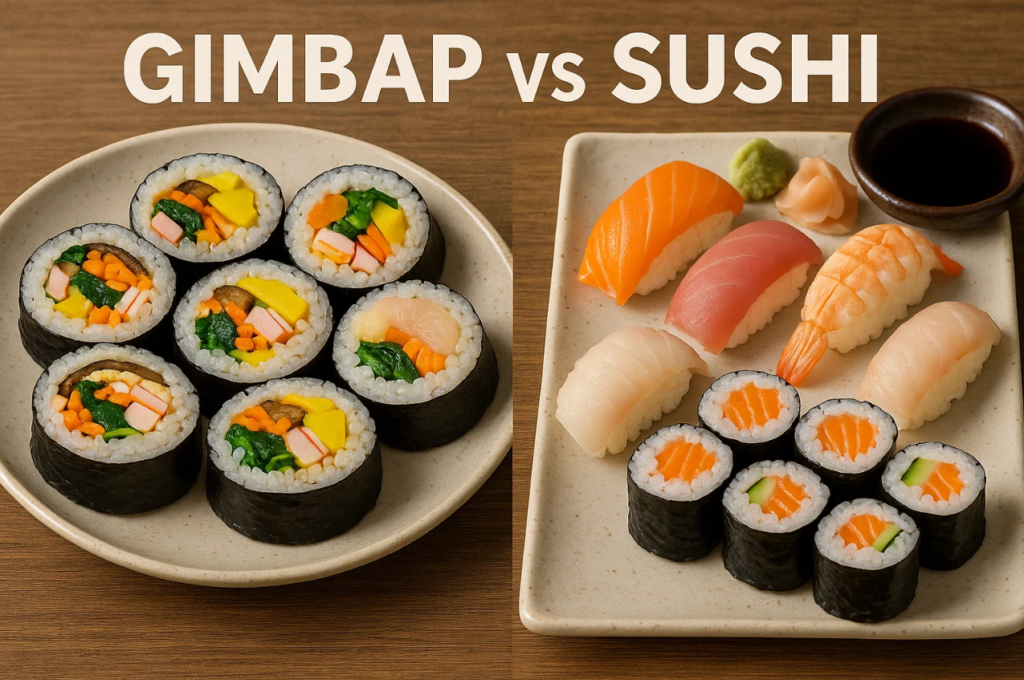Gimbap(김밥) : Korea’s Everyday Roll of Care, Culture, and Convenience
Gimbap (김밥) is more than a roll of rice. It’s Korea’s go-to meal for lunch, travel, and comfort, shaped by culture and shared with heart.

Gimbap(김밥) : Korea’s Everyday Roll of Care, Culture, and Convenience
If there’s one food that captures the heart of Korean everyday life, it’s gimbap(김밥).
At home in school lunchboxes, convenience stores, mountain trails, and even picnic mats by the Han River, this rolled meal is more than just practical—it’s packed with flavor, memory, and meaning.

While it may look like sushi at first glance, gimbap(김밥) tells a different story.
▌Gimbap(김밥) vs Sushi : Familiar Shape, Different Spirit

To many, gimbap(김밥) might look like sushi, but the similarity ends there. Korean gimbap(김밥) uses sesame oil-seasoned rice, and its fillings are fully cooked—think egg, ham, spinach, crab stick, and pickled radish. It’s not about raw fish or minimalism—it’s about heartiness and color.
Where sushi can be a special-occasion dish, gimbap(김밥) is made for everyday life. It’s the sandwich of Korean cuisine: quick to pack, satisfying to eat, and perfect on the move.
▌A Roll for Every Taste
Part of gimbap(김밥)’s magic is its versatility. Over time, Koreans have created countless variations to suit different moods and meals:
- Chungmu Gimbap(충무김밥): Plain rolls served with spicy squid and radish

- Nude Gimbap(누드김밥): Rice on the outside, seaweed inside—a Korean twist on the inside-out roll

- Mayak Gimbap(마약김밥): Mini rolls with addictive dipping sauce

Each variation highlights how gimbap(김밥) adapts and evolves—while still staying true to its original purpose: a complete, portable meal.
▌When and How Koreans Eat Gimbap(김밥)
You don’t need a special occasion to eat gimbap(김밥)—in fact, it’s most loved for how ordinary and comforting it is.
- Field trips and hikes: Packed by parents with care and color
- Lunch breaks: Office workers and students alike reach for it
- Convenience stores: Tuna, bulgogi, and spicy pork gimbap(김밥) are always stocked and ready
Eating gimbap(김밥) is often tied to moments of transition—on the way to something, or a break from something—making it more than just a bite. It’s a brief pause with flavor.
▌Why Gimbap(김밥) Stays in the Heart
Beyond taste, gimbap(김밥) represents a certain thoughtfulness. Each roll takes time to prepare, ingredients are balanced not just for nutrition, but for color and texture. There’s beauty in how it’s rolled—tight, neat, and shareable.
It’s also deeply communal: made in batches, eaten in groups, often shared without ceremony. Whether picked up in a rush or made at home with care, gimbap(김밥) quietly delivers something deeper—comfort, familiarity, and a reminder of someone’s effort.
“Discover Korea, one story at a time.”
“하나의 이야기로 한국을 만나보세요.”
If you enjoyed this story, share it with someone who’d love it too.